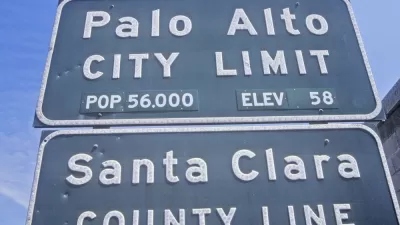In some places, it might be hard to imagine even considering a cap on the development of commercial development. Palo Alto, home to Stanford University and a hot bed of California's tech industry, did just that in City Council earlier this week.
"Palo Alto's polarizing debate over office growth hit a stalemate Monday night when a deeply divided City Council agonized over the topic for more than four hours before deciding not to move ahead with any dramatic development restrictions just yet," reports Gennady Sheynar.
The proposal would cap commercial development in the city at an annual limit of 35,000 to 50,000 square feet of new office space every year. The motivation behind the law, naturally, concerns parking and traffic. The cap would be added to an update of the city's Comprehensive Plan.
Opponents of the plan, which include several councilmembers and the city's Chamber of Commerce, "urged the council not to move ahead with a building restriction, which they argued would threaten downtown's vitality without achieving anything useful," according to Sheynar.
"[Palo Alto City Councilmember Marc] Berman ticked off a list of initiatives that the city is already pursuing to address these issues, which include a new downtown Residential Parking Permit Program that would restrict the amount of time employees can park in residential areas; a new Transportation Management Association that would offer businesses incentives to switch from cars to other modes of transportation; and an expansion of the city's shuttle system."
The Peninsula Transportation Alternatives blog and Nathan Donato-Weinstein also provided coverage of the proposal in the days leading up to Monday's hearing.
FULL STORY: Palo Alto divided over proposed office cap

Alabama: Trump Terminates Settlements for Black Communities Harmed By Raw Sewage
Trump deemed the landmark civil rights agreement “illegal DEI and environmental justice policy.”

Planetizen Federal Action Tracker
A weekly monitor of how Trump’s orders and actions are impacting planners and planning in America.

Why Should We Subsidize Public Transportation?
Many public transit agencies face financial stress due to rising costs, declining fare revenue, and declining subsidies. Transit advocates must provide a strong business case for increasing public transit funding.

Understanding Road Diets
An explainer from Momentum highlights the advantages of reducing vehicle lanes in favor of more bike, transit, and pedestrian infrastructure.

New California Law Regulates Warehouse Pollution
A new law tightens building and emissions regulations for large distribution warehouses to mitigate air pollution and traffic in surrounding communities.

Phoenix Announces Opening Date for Light Rail Extension
The South Central extension will connect South Phoenix to downtown and other major hubs starting on June 7.
Urban Design for Planners 1: Software Tools
This six-course series explores essential urban design concepts using open source software and equips planners with the tools they need to participate fully in the urban design process.
Planning for Universal Design
Learn the tools for implementing Universal Design in planning regulations.
Caltrans
Smith Gee Studio
Institute for Housing and Urban Development Studies (IHS)
City of Grandview
Harvard GSD Executive Education
Toledo-Lucas County Plan Commissions
Salt Lake City
NYU Wagner Graduate School of Public Service




























